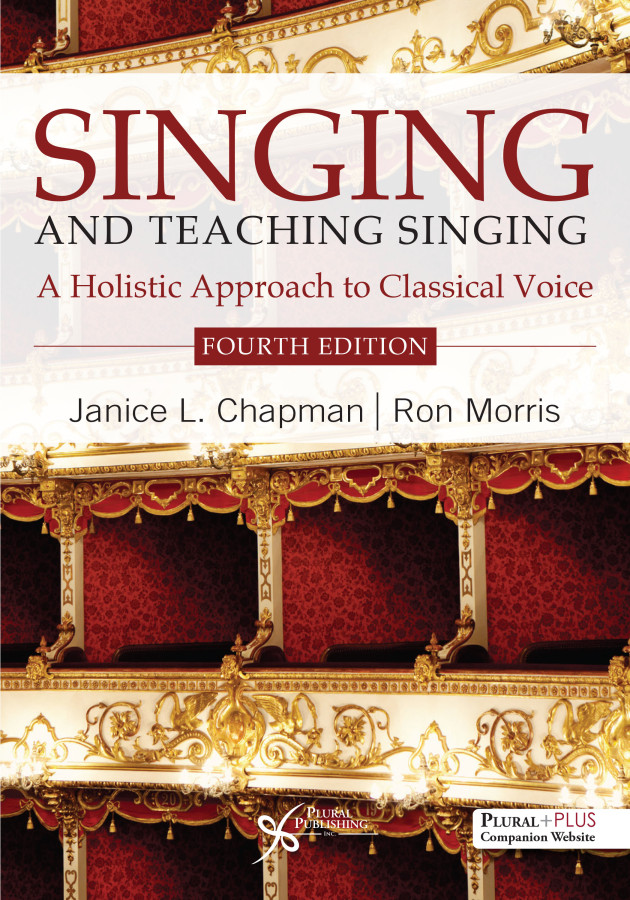The Singer’s Library: Singing and Teaching Singing

Singing and Teaching Singing: A Holistic Approach to Classical Voice by Janice L. Chapman and Ron Morris has had an impressive evolution over the last two decades. The first edition was released by Plural Publishing in 2005, followed by a second edition in 2011 and a third in 2016, each of which featured significant additions and updates. The newest fourth edition, however, is a robust 620 pages—a full 220 pages longer than the third edition. The bonus material in the latest edition includes both new chapters and expanded existing chapters.
Author and pedagogue Janice Chapman had a 35-year singing career, including performing at major opera houses throughout Europe, appearing in broadcasts for the BBC, and winning the Kathleen Ferrier Competition in London. Concurrent with much of her performing, she has also maintained a 40-year research and teaching career, which includes international conference presentations and a long-term appointment at the Royal Academy of Music. She is currently a voice professor at the Guildhall School of Music and Drama. Co-author Ron Morris has trained as a speech therapist, audiologist, and classical singer. A long-time student of Chapman’s, he is a senior lecturer in vocal pedagogy and vocal health at Griffith University’s Queensland Conservatorium of Music in Australia.

Several of the new contributions in the fourth edition of Singing and Teaching Singing have come from guest authors. Marilyn McCarthy shares advances in neuroscience and education in two new chapters: “Teaching and Learning With the Brain in Mind” and “Reflective Practice and the Capabilities Profile for Singing Teachers.” David M. Howard updated and expanded Adrian Forcin’s chapter, “Hearing and Singing.” Two other guest chapters were similarly updated and expanded: John S. Rubin’s chapter on vocal and respiratory anatomy and physiology and Jacob Lieberman’s chapter on manual therapy in the management of voice disorders. James Platt also compiled a glossary of terms that is new to the fourth edition.
Chapman, Morris, Platt, and Howard contributed new chapters on laryngeal registration, vocal acoustics, and acoustic registration. They also expanded the section on singing exercises—previously listed in an appendix—and gave it its own chapter, including advice on warm-ups, cool-downs, practice skills, and voice-building exercises. According to the authors, every chapter in the book has been revised and updated in some way, with the intention of incorporating the latest advances from voice science, function, and pedagogy, including more thorough references and citations throughout. Like many Plural Publishing books, it comes with a companion website with additional resources.
Chapman states in the introduction that her teaching has continually evolved and changed over the years based on what she has been able to “learn, borrow, appropriate, or rediscover.” Over time, her pedagogy has developed in a way that better allows her to tailor her teaching to suit her students’ needs and lifestyles. As such, she states that the fourth edition of Singing and Teaching Singing “aims to lay down the principles of my methodology as it stands at this point in time.”
Chapman believes teachers should respect the “myths and the imagery” that were part of the teaching practices of previous generations. However, she also acknowledges that those practices need “translation and validation” as the field moves forward. She hopes that advances in scientific, anatomical, and multidisciplinary knowledge can move us toward a more common language, which will benefit all parties when communicating across disciplines. She also notes the need for both “accurate science and information as well as a holistic appreciation of the art of singing and its practitioners.”
The fourth edition of Singing and Teaching Singing is a substantial volume. The authors’ desire to keep the book current by sharing the latest advances in voice pedagogy is admirable and desperately needed as the field changes in meaningful ways. It is a useful resource that readers can return to often for reliable information and ideas for creative and effective instruction.
